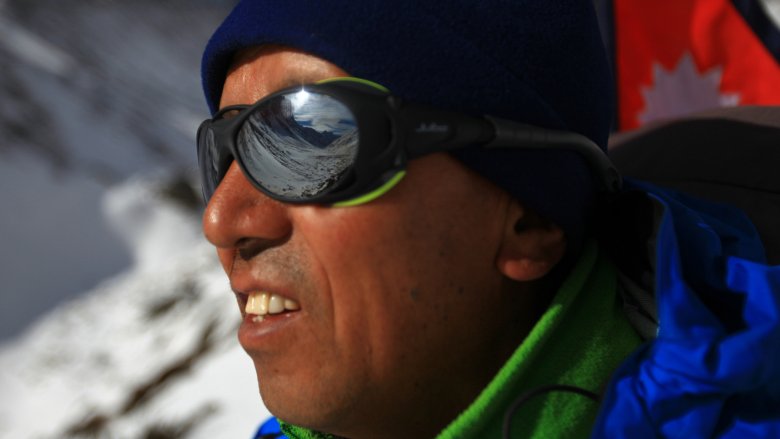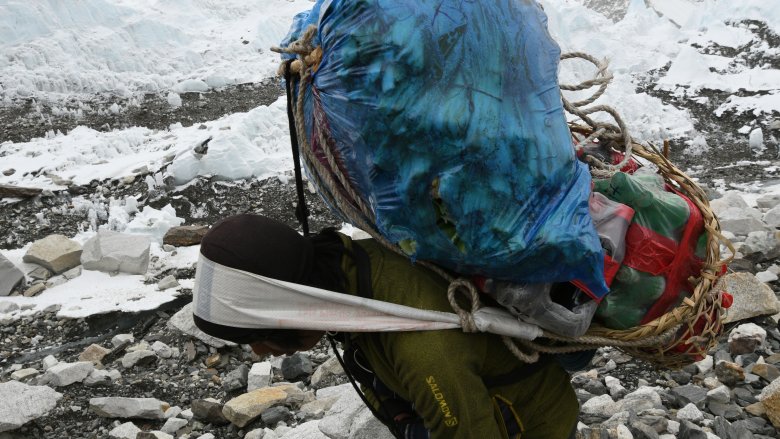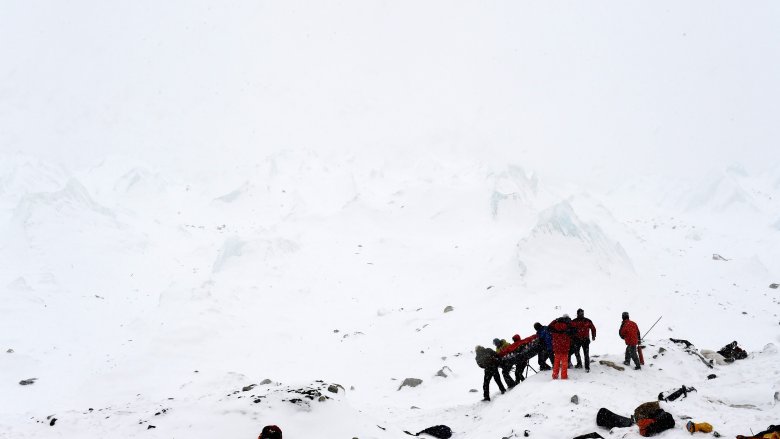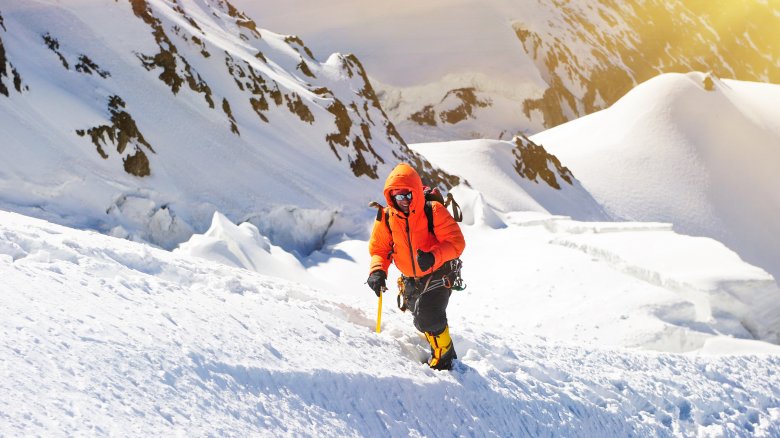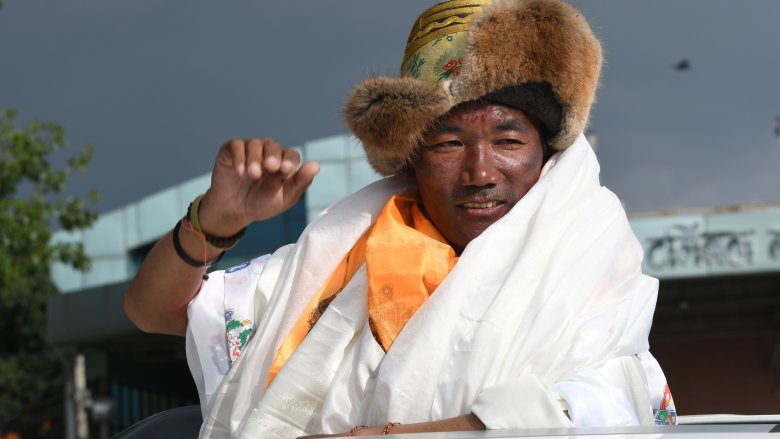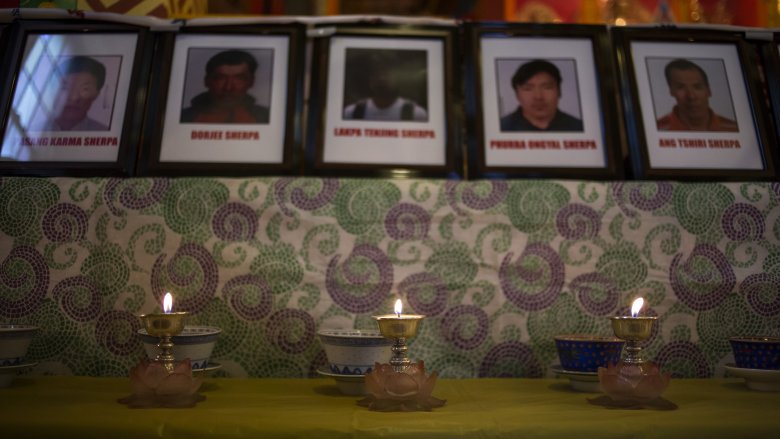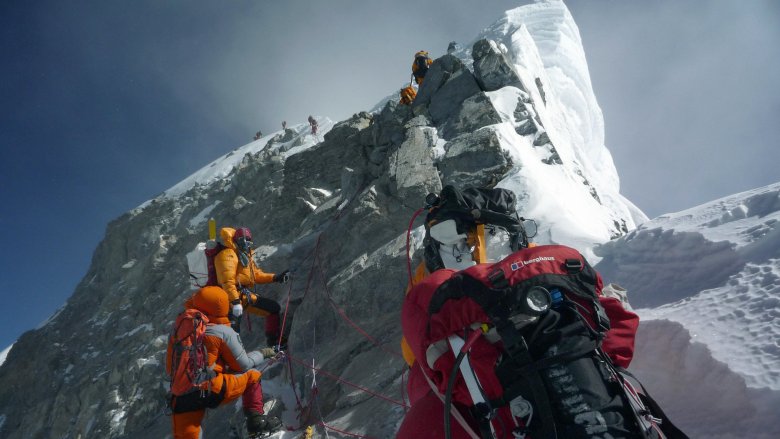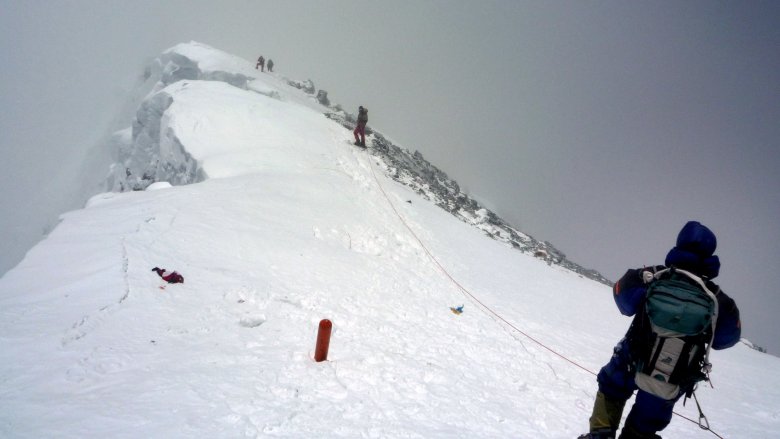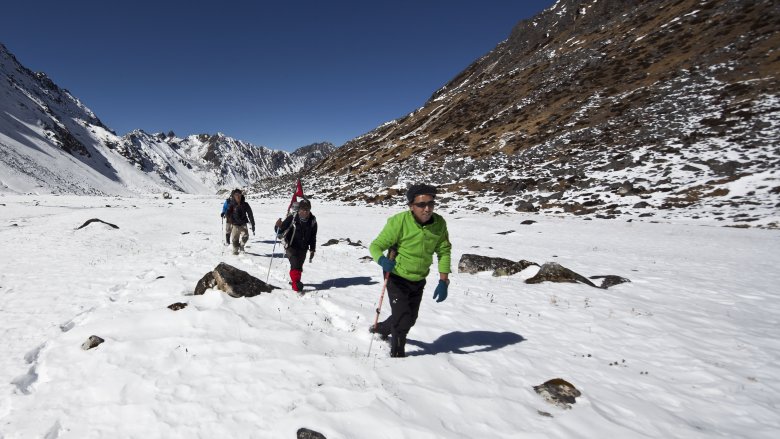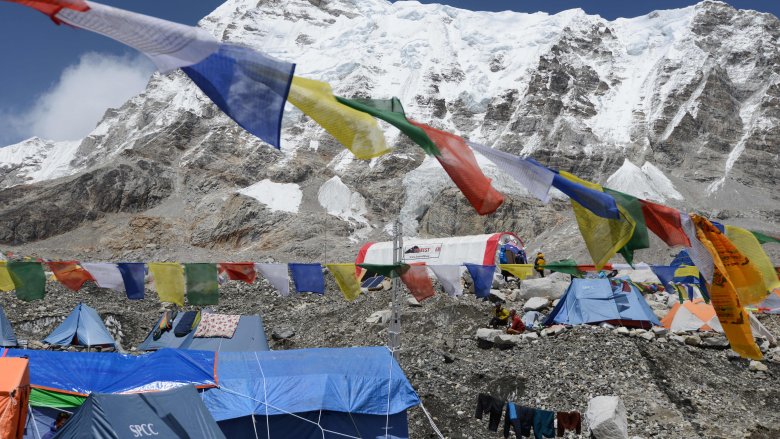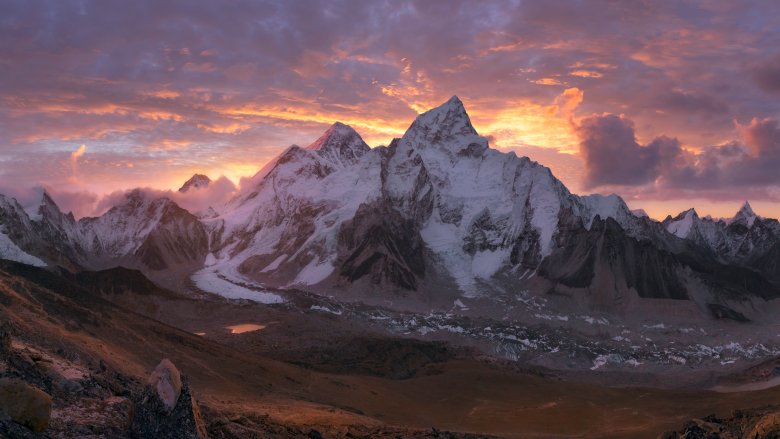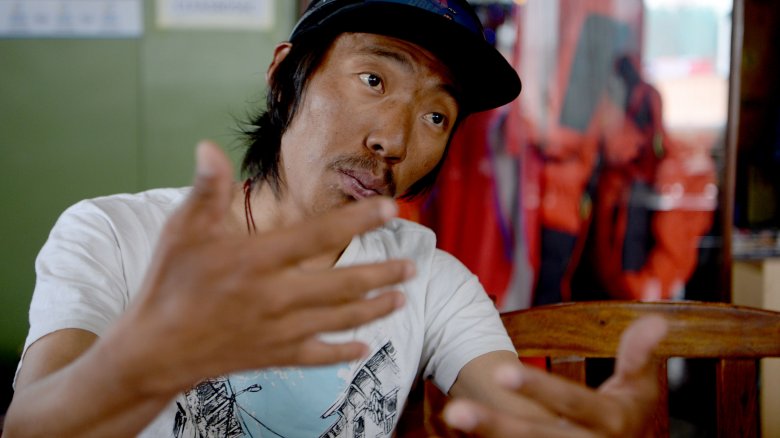What It's Really Like To Be A Sherpa On Mt. Everest
There are few places on Earth that evoke quite the same sense of wonder, adventure, and intimidation as Mt. Everest. It wasn't that long ago — 1953, to be precise — that Sir Edmund Hillary first scaled the peak that had forced so many others to turn back in defeat.
At his side was a Nepalese mountain climber named Tenzing Norgay, the Sherpa who actually shows up in some of the most famous photos of that momentous climb. Everyone knows that Hillary became famous and scored a knighthood, but less well-known is that while he'd intended on making many more ascents to the highest place on earth, he became more interested in something else: helping the Nepalese people who'd made his feat possible.
Hillary would spend the rest of his life going on some pretty awesome adventures, and helping to build hospitals, schools, clinics, and even several airstrips that would open Everest to the world. But he never would've been able to do it if the Sherpas hadn't helped him first.
Today — just like back then — it's the Sherpas who help foreign climbers make it up and down that mountain. So what's it really like to escort groups of climbers up to the highest point in the world?
What, exactly, are sherpas responsible for?
Simply put, no one would ever climb Mt. Everest if it wasn't for the sherpas. But first, we need a little clarity. As Project Himalaya notes, "sherpa" is a job. "Sherpa" with a capital "S" refers to the people who live high up in the mountains of Nepal, and they're a distinct ethnic group.
It's also used as a name, and when the BBC spoke to Karma Sherpa, they found that sherpas do pretty much everything. Off the mountain, Karma runs a travel company that books treks to Everest and the surrounding mountains. On the slopes, though, it's much more difficult.
So up on mountain, these guys are technically called "climbing sherpas," and they do everything from scouting ahead and fixing ropes and ladders to serving meals. They're also the ones carrying all the gear — including oxygen tanks — once the trek gets above the levels of Base Camp. (Below Base Camp, that's the job of non-Sherpa porters.)
The gear hefted onto a sherpa's mighty shoulders can weigh up to 150 pounds, and according to Apa Sherpa (via The Washington Post), sherpas will go back and forth over an icefall as many as 20 times. After all, they're the ones making camp and carrying luggage, while the people they're escorting might make these precarious crossings just a few times. There's also a specific group of sherpas called "Icefall doctors," and NPR says it's their job to attach ropes and ladders to sheer ice faces, a job that can require them to work 16 hours a day.
A sherpa's death probably won't make the news
It's no secret that Everest still claims a lot of lives, even into the 21st century. Every so often, news of a climber's tragic death will make headlines, but the media rarely mourns the death of a sherpa. And they die a lot — about 40 percent of all mountainside deaths are sherpas.
That's tragic, but even more tragic is what comes after death. There are some condolences, maybe a plaque, and an insurance payment that's nowhere near enough. Then, it's business as usual, for everyone but the families.
DaRita Sherpa died on May 5, 2013, leaving behind a wife and two daughters too young to remember him. When National Geographic talked to his father-in-law, he told them that every time his daughter saw a sherpa walking down from Base Camp — the walk her husband didn't get to make after that last fateful trip — she would start to cry. Reminders of the mountain that claimed the lives of loved ones is ever-present for those who survive, and Nat Geo says many sherpas and their families can tell tales of loved ones lost to Everest.
Karsang Sherpa lost several uncles to the mountains, and says that the typical insurance payment is around $11,000. Given that it takes about $5,000 to perform the funeral rituals, that doesn't leave much behind for the families — except grief and a constant, gigantic reminder.
The job has been steadily and relentlessly commercialized
The very first time a Sherpa was hired for a mountaineering expedition was in 1907, and according to National Geographic, their lives have changed considerably since then.
When they were first hired, they had no word for "summit." They couldn't believe that these crazy foreigners wanted to climb a mountain for no other reason than just for the sake of climbing, and they were convinced there was some other reason for the expeditions. Surely, there must be some serious, Indiana Jones-styles treasure up there ... right?
Since then, Sherpas have turned mountain climbing into a commercial endeavor, and the business side of things really started kicking off in the 1990s — so much so that American Scott Fischer once commented, "We've built a yellow brick road to the summit." Now, "sherpa" doesn't just mean someone who climbs mountains, it also refers to a "shrewd businessman" in Nepalese slang. That's pretty accurate, as many sherpas now subcontract out some of the less skilled work to non-Sherpas.
Is that a good thing or bad? In a way, it's been good for the Sherpas. They have better gear and better pay now, and that's a huge step up from the leather boots they once climbed in.
Deciding when to tell someone they can't make it up Mt. Everest
Kami Rita Sherpa (pictured) has led dozens of expeditions up Everest. He — and other sherpas like him — have a huge responsibility on their shoulders, and he told the BBC that sometimes, it's not just about getting people to the top.
Sometimes, it's about knowing when to turn back.
In 2019, he was leading an expedition that included one climber who was struggling by the time they reached 23,500 feet. The summit was another 7,000 feet above, and when it took her twice as long as expected to get from Base Camp to Camp 2, Kami made the decision that her trip to the top just wasn't going to happen. He called a helicopter and had her taken off the mountain.
"I always try to make sure every client succeeds to the summit," he said. "But there is a line. The moment I realize that any of my clients will not make it, I will abort the mission. ... If in doubt, descent is always be best decision, because Everest will always be there if you survive."
What's that rumbling sound?
Lakpa Rita Sherpa is known as one of the best. He's led hundreds of people to the top of Everest, and he told Red Bull that in all expeditions he's been on, he's been buried in an avalanche three times: in 1984, in 1986, and in 2012. Only that first time was on Everest, but that doesn't take away from how absolutely terrifying the experience must be.
"Sometimes you can simply not avoid avalanches," he said, before adding, "There isn't much you can do if something comes down right above you."
In 2014, National Geographic reported that an avalanche in the Khumbu Icefall had led to the worst accident in Everest's history. Sherpas were carrying gear back and forth across the Icefall when snow and ice started falling from the glacial overhangs above. A shocking 13 people died, three more were immediately reported missing, and more were injured.
And this is one threat that's getting worse. According to Vox, global warming is causing the highest elevations in the world to warm faster. That's leading to more and more avalanches, especially in the Himalayas, prompting the development of a terrifying map with a whole bunch places labeled "potential release areas." The job of a sherpa just got even more frightening.
Violence is a part of the sherpa business
The higher climbers climb, the less oxygen there is in the air. When climbers start feeling the effects of that, it's called hypoxemia. According to the Cleveland Clinic, people can start to experience things like shortness of breath and confusion. That's terrifying, because it means that suddenly, sherpas could be faced with someone who's trying to kill them.
Just take the incident Tenjing Dorji recounted to National Geographic. He was on the side of the mountain when his client suddenly declared that he was going to be the first one to the top — by himself — and then started swinging his ice ax at his guide. When Tenjing demanded to know what he was doing, the response was chilling: "I'm trying to kill you!"
The two — tied together for safety — slipped on the steep ice and were only saved because their line got hooked on something. His tale isn't the only one of the sort, but when sherpas do tell stories of the abuse they suffer on the side of Everest, there's a lot of people who don't believe that it happens.
Unless, of course, it makes international news. In 2013, a group of sherpas faced off against a group of Western climbers at 21,000 feet. The Telegraph reported the fight lasted almost an hour, and only ended with the intervention of an American woman and the retreat of the climbers.
Getting up Mt. Everest is only half the battle
Climbing Everest is definitely not easy, in spite of what some will say. It's a rumor that's potentially deadly, and as Kami Rita Sherpa told the BBC, "Overcrowding is nothing new. This is not the reason people are dying. It's the pressure on young climbers by some companies describing Everest as easy. Everest is never easy."
And while most people only think of climbing to the top of Everest, that's only half the story. Once you're there, you need to get back down — and that's where another vital part of the sherpa's job comes in.
The area between Camp 4 and the summit is known as the "death zone," and once climbers get to this point, around 95 percent of them are relying on supplemental oxygen they — or rather, their sherpas — have hauled up the mountain. Kami says that one of the vital parts of keeping everybody safe is monitoring everyone's oxygen use to make sure they have enough to get up and back down again. At those heights, it's a matter of life and death.
It's not just a job, it's a way of life
While climbing Mt. Everest might be just a small part of the year for foreigners, Lakpa Rita Sherpa told Red Bull that he and his fellow sherpas spend an average of eight months a year away from their families. "All sherpas miss a lot and get homesick for our families and friends," he said, "but this is what I do, and I am always focusing on what I am doing."
And they don't really have much choice. When The Washington Post asked Apa Sherpa (pictured) just why they kept going back to the mountain, he had this to say: "Climbing the Everest is a routine for Sherpas like me. We are way behind in education. There are no other options to meet our most basics of ends. So, regardless of all the risks involved in climbing the mountain, the Sherpas do it. ... We keep on climbing more than once because we have to climb it."
Many, says Lakpa, have been training for the life of a sherpa since the day they were born — and not in the traditional way. He describes a youth spent walking miles to get the most basic supplies for his family, carrying heavy loads back and forth, and when he went to school, having to walk four hours to get there and home again. Many don't train for the climb like Westerners do. They train by living a very, very hard life.
Being a sherpa today is easier ... but not easy
Apa Sherpa started climbing Everest in 1990, and since then, he's averaged about one trip a year. When The Washington Post asked him what's changed, he said that there's been quite a bit.
It's almost unthinkable, but the first time he climbed the mountain, the only bit of technology he had was a short-range walkie talkie. That's it. Needless to say, there's more access to technology today, and Apa says the most important thing they've got now is up-to-the-minute weather reports.
It's not all changed for the better, though, and he adds that it's still hard, and there are some changes that make it even harder. When he started, there was more snow on the mountain. "Now," he said, "lesser snow on the ice-rocks means higher chance of falling."
And with more people going up and down now, that means there's also the need to wait in line. That wait can be deadly. Climbers can run out of oxygen with the unexpected delays, and frostbite is more common. They may have some technology now, but the sherpa's job is always a challenging one where death is just a misstep away.
Bringing the dead down from Mt. Everest
In 2019, the BBC reported that the glaciers of Everest were melting and revealing more and more bodies of those who'd tried to reach the top, failed, and died along the way. An estimated 200 or so corpses are thought to still be on the mountain. And when hands and legs start to be exposed by the shrinking ice, the sherpas are the ones sent in to bring the bodies down.
According to The Washington Post, the cost of retrieving a body can run as much as $70,000, and sometimes it costs even more: the lives of the sherpas sent up. In 1984, a climber and his guide died in their attempt to recover the body of a German mountaineer, and eerily, it wasn't until 2010 that a real effort was made to clear the bodies from the so-called "death zone" near the summit.
And it's a logistical nightmare. It usually takes between six and ten sherpas to retrieve a single body, which can weigh as much as 330 pounds once you factor in the weight of the gear and attached ice.
Some bodies remain, like "Green Boots." That's the nickname for the remains of a climber named Tsewang Paljor, who died under an overhang, and his green boots — still on his body — point in the direction of the trail. And yes, his family knows that he's been a trail marker many step over on their way, and it's heartbreaking.
Sherpas are guided by serenity and selflessness
Making the trip up and down Everest over and over again has got to be insanely difficult, and then add in ungrateful Westerners who get all the credit, and seriously, how does anyone do it?
The BBC asked Karma Sherpa how the community felt about doing all the work and having Western climbers get all the credit and break all the records, and he had this to say: "Sherpa people, they don't really care. They are more into helping people and getting people to the top. ... If someone has success, then we all should be happy. That's what Buddhism and Sherpa culture teaches."
That's ... amazing. And if the whole world had that sort of outlook on things, it would be a better place.
Kami Rita Sherpa also told BBC that he rarely thought about breaking records, but he did think about respecting the mountain and its goddess. "It's our responsibility to keep the goddess happy," he explained. "Months before I start an ascent, I start worshiping and ask for forgiveness because I will have to put my feet on her body."
There's also a belief in good and bad years, as Karsang Sherpa told National Geographic. Even though Sherpas try to avoid angering the deities — and perform a pre-climb ceremony at Everest's Base Camp — they also believe that there are some years the mountain deity Miyolangsangma just wants to be left alone ... and will make that very clear to those who insist on disturbing her.
They're just built better
If it seems that Sherpas are just naturals at climbing mountains, there's a good reason for that — they literally are.
Physiologists at the University of Cambridge (via NPR) looked at why Sherpas were such good, well, sherpas, and they studied both Sherpas and what they called "lowlanders" on an Everest trip in 2013. The two groups were exposed to the same conditions in the weeks before the study, given the same food, and then the test subjects gave up some blood and muscle tissue samples for testing. Scientists found that the group of Sherpas actually had mutations in their DNA that made their cells better at turning oxygen into energy.
They were also better at producing energy without the use of oxygen at all, and that basically means that Sherpas are superhumans. They've adapted to life in low-oxygen, high-altitude environments, so if they make it look pretty easy, that's because they're way, way more badass than the average person.
